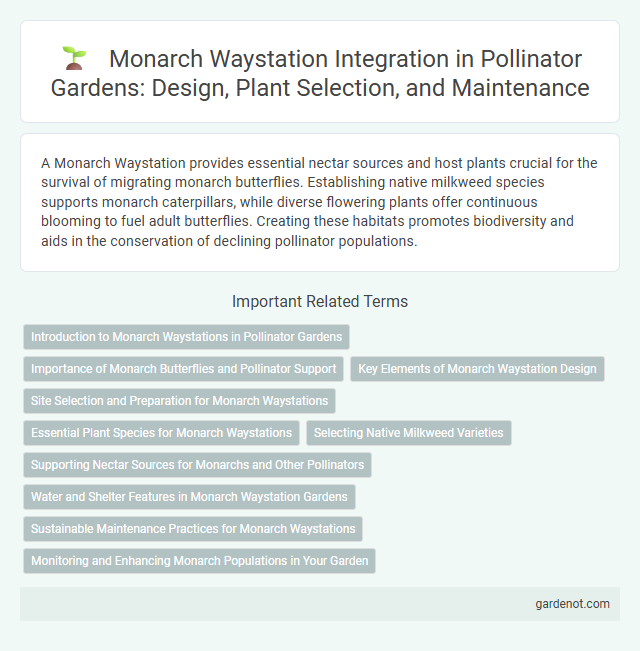A Monarch Waystation provides essential nectar sources and host plants crucial for the survival of migrating monarch butterflies. Establishing native milkweed species supports monarch caterpillars, while diverse flowering plants offer continuous blooming to fuel adult butterflies. Creating these habitats promotes biodiversity and aids in the conservation of declining pollinator populations.
Introduction to Monarch Waystations in Pollinator Gardens
Monarch Waystations are designated habitats that provide essential resources such as milkweed and nectar plants crucial for the survival of monarch butterflies during their migration. These waystations play a vital role in supporting pollinator populations by offering breeding and feeding grounds within pollinator gardens. Establishing Monarch Waystations enhances biodiversity and contributes to the conservation of monarch butterflies facing habitat loss and environmental threats.
Importance of Monarch Butterflies and Pollinator Support
Monarch waystations play a vital role in supporting pollinator populations by providing essential nectar sources and breeding habitats for Monarch butterflies. Monarchs contribute significantly to pollination, aiding the reproduction of numerous flowering plants and maintaining ecosystem health. Establishing and maintaining these waystations enhances biodiversity and supports the survival of this endangered species amid habitat loss and declining populations.
Key Elements of Monarch Waystation Design
Monarch Waystation design incorporates native milkweed species to provide essential larval host plants, alongside a diverse array of nectar-rich flowering plants blooming from spring through fall to sustain adult monarchs. The garden layout emphasizes sheltered, sunny locations with minimal pesticide exposure, ensuring a safe habitat for all life stages of monarch butterflies. Incorporating water sources, proper soil conditions, and signage for educational purposes enhances the ecological effectiveness and community engagement of the waystation.
Site Selection and Preparation for Monarch Waystations
Selecting a site for a Monarch waystation requires full sun exposure of at least 6-8 hours daily and well-drained soil to support the growth of milkweed and nectar plants vital for monarch butterflies. Preparing the site involves removing invasive species, tilling the soil to improve aeration, and introducing native milkweed varieties such as Asclepias tuberosa and Asclepias syriaca along with diverse nectar sources to provide continuous bloom throughout the monarch's breeding season. Proper site preparation and selection enhance habitat quality, boosting monarch reproduction and migration success.
Essential Plant Species for Monarch Waystations
Essential plant species for Monarch Waystations include milkweed varieties such as Asclepias syriaca (common milkweed) and Asclepias tuberosa (butterfly weed), which provide critical larval host plants for monarch caterpillars. Native nectar plants like purple coneflower (Echinacea purpurea), goldenrod (Solidago spp.), and blazing star (Liatris spicata) offer vital energy sources for adult monarchs during migration. Incorporating these species ensures a sustainable habitat that supports monarch reproduction and enhances pollinator biodiversity.
Selecting Native Milkweed Varieties
Selecting native milkweed varieties such as Asclepias syriaca, Asclepias tuberosa, and Asclepias incarnata is crucial for creating an effective Monarch Waystation. These species provide optimal habitat and nourishment for monarch caterpillars while supporting local ecosystems and promoting biodiversity. Incorporating region-specific milkweed ensures better growth, resilience, and successful monarch breeding.
Supporting Nectar Sources for Monarchs and Other Pollinators
Monarch Waystations are critical habitats designed to provide abundant nectar sources essential for monarch butterflies and other pollinators throughout their migration. Planting a diverse array of native flowering plants such as milkweed, coneflowers, and goldenrod ensures continuous bloom cycles that supply vital energy for pollinators. These waystations help restore nectar availability disrupted by habitat loss, supporting pollinator health and biodiversity.
Water and Shelter Features in Monarch Waystation Gardens
Monarch Waystation gardens incorporate essential water and shelter features critical for supporting monarch butterflies. Shallow water sources, such as mud puddles or birdbaths with pebbles, provide hydration and vital minerals for monarchs during migration. Strategically placed shrubs and tall native grasses offer shelter from predators and harsh weather, creating a safe haven for monarchs to rest and thrive.
Sustainable Maintenance Practices for Monarch Waystations
Sustainable maintenance practices for Monarch Waystations include planting native milkweed species critical for Monarch butterfly reproduction and minimizing pesticide use to protect pollinator health. Installing rainwater catchment systems supports drought resilience by providing a consistent water source while reducing environmental impact. Regular monitoring and adaptive management ensure the habitat remains favorable for Monarch migration and population growth throughout the seasons.
Monitoring and Enhancing Monarch Populations in Your Garden
Monarch waystations provide critical habitats that support monarch butterfly migration by offering milkweed and nectar sources essential for breeding and feeding. Monitoring monarch populations includes regularly recording sightings of eggs, larvae, and adults, which helps track local population health and the effectiveness of conservation efforts. Enhancing monarch populations involves planting native milkweed species, minimizing pesticide use, and maintaining diverse floral resources to sustain monarchs throughout their life cycle.
Monarch waystation Infographic

 gardenot.com
gardenot.com